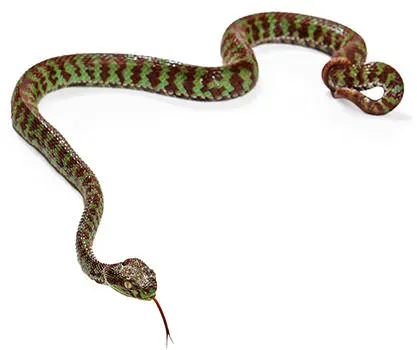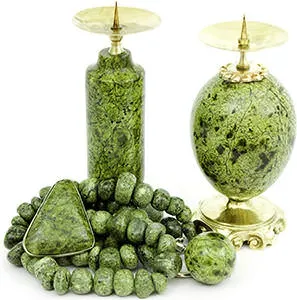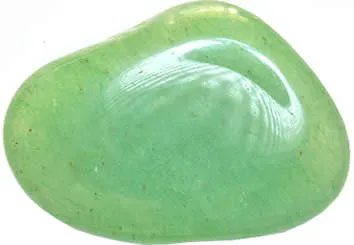 Serpentine is named for the snakeskin it is said to resemble as it shares the same green speckled skin of the serpent. Serpentine has been used for ornaments and jewelry for thousands of years, as it is suitable for carving and polishes to an attractive gem. Serpentine may be confused with jadeite or nephrite because of its similar coloration, and is sometimes known as 'Koren
Serpentine is named for the snakeskin it is said to resemble as it shares the same green speckled skin of the serpent. Serpentine has been used for ornaments and jewelry for thousands of years, as it is suitable for carving and polishes to an attractive gem. Serpentine may be confused with jadeite or nephrite because of its similar coloration, and is sometimes known as 'Koren ![]() jade', 'serpentine jade' or 'new jade'. Serpentine however, is softer and scratches more easily than true jade, but it is often used as a jade substitute. Using the term jade to describe serpentine is a misnomer. The term relates to the uses made of these materials as a result of certain properties they possess, rather than to their actual mineralogical status. The term 'serpentine' covers a group of related minerals that are widely distributed around the world.
jade', 'serpentine jade' or 'new jade'. Serpentine however, is softer and scratches more easily than true jade, but it is often used as a jade substitute. Using the term jade to describe serpentine is a misnomer. The term relates to the uses made of these materials as a result of certain properties they possess, rather than to their actual mineralogical status. The term 'serpentine' covers a group of related minerals that are widely distributed around the world.
 In ancient times, serpentine was thought to be a cure for poison. Amulets of serpentine were worn to protect against snakebites or poisoning. Legend holds that a king was reputed to have insisted that his chalice be made of serpentine, as it was believed that if a poison were put into his drink in a serpentine vessel, the vessel would sweat on the outside. It was also believed that the effectiveness of a medicine was increased when drank from a serpentine vessel. However, serpentine has mainly been used to carve figurines or vases, which is typical of Chinese art. Elaborate vases with hanging chains, carved out of a single piece of stone, were not uncommon.
In ancient times, serpentine was thought to be a cure for poison. Amulets of serpentine were worn to protect against snakebites or poisoning. Legend holds that a king was reputed to have insisted that his chalice be made of serpentine, as it was believed that if a poison were put into his drink in a serpentine vessel, the vessel would sweat on the outside. It was also believed that the effectiveness of a medicine was increased when drank from a serpentine vessel. However, serpentine has mainly been used to carve figurines or vases, which is typical of Chinese art. Elaborate vases with hanging chains, carved out of a single piece of stone, were not uncommon.
 Today, serpentine is more often used for the large-scale production of lower quality items, as it is less expensive than true
Today, serpentine is more often used for the large-scale production of lower quality items, as it is less expensive than true ![]() jade, and easier to work with. Serpentine ranges in color from grayish green, brown, yellow, and greenish white to soft pale green. Sometimes, groups or rows of small, striking white cloud shapes are visible on the inside of the stones. Yellow-green to definite-green varieties of serpentine are less common. Multi colored pieces are also found with light-green to green, yellow-green, or brown patches within. Serpentine rates a 2.5 to 5 on the hardness scale. Because it is soft, it is not suitable for rings. It is a translucent to opaque stone with a greasy, waxy, silky or dull luster. Serpentine is a secondary mineral formed from minerals such as olivine (
jade, and easier to work with. Serpentine ranges in color from grayish green, brown, yellow, and greenish white to soft pale green. Sometimes, groups or rows of small, striking white cloud shapes are visible on the inside of the stones. Yellow-green to definite-green varieties of serpentine are less common. Multi colored pieces are also found with light-green to green, yellow-green, or brown patches within. Serpentine rates a 2.5 to 5 on the hardness scale. Because it is soft, it is not suitable for rings. It is a translucent to opaque stone with a greasy, waxy, silky or dull luster. Serpentine is a secondary mineral formed from minerals such as olivine (![]() peridot) and orthopyroxene. There are two basic forms of the mineral: the antigorites and the chrysotiles. Antigorites are flaky, while chrysotiles are fibrous and are the source of asbestos. Although serpentine is related to asbestos, which is a carcinogen, it is not a cancer risk unless it is fibrous. Serpentine that contains asbestos is usually placed in sealed containers when displayed.
peridot) and orthopyroxene. There are two basic forms of the mineral: the antigorites and the chrysotiles. Antigorites are flaky, while chrysotiles are fibrous and are the source of asbestos. Although serpentine is related to asbestos, which is a carcinogen, it is not a cancer risk unless it is fibrous. Serpentine that contains asbestos is usually placed in sealed containers when displayed.
 Serpentine sometimes occurs in igneous rocks, but more often occurs in serpentinites, which have been formed by the alteration of olivine bearing rocks. Most of these specimens are grayish green in color and they give this color to the rocks in which they occur. Other various colored serpentine also occur, and these are the stones most popular for jewelry. A yellowish-green variety of serpentine called Bowenite, which resembles jadeite, is found in China, New Zealand and the United States. A dark green variety with small black flecks within, called Williamsite, is found in China, Italy and the United States. Other varieties of serpentine are found around England, New Zealand, Korea, China, and the United States. Serpentine is a stone that represents success and courage.
Serpentine sometimes occurs in igneous rocks, but more often occurs in serpentinites, which have been formed by the alteration of olivine bearing rocks. Most of these specimens are grayish green in color and they give this color to the rocks in which they occur. Other various colored serpentine also occur, and these are the stones most popular for jewelry. A yellowish-green variety of serpentine called Bowenite, which resembles jadeite, is found in China, New Zealand and the United States. A dark green variety with small black flecks within, called Williamsite, is found in China, Italy and the United States. Other varieties of serpentine are found around England, New Zealand, Korea, China, and the United States. Serpentine is a stone that represents success and courage.